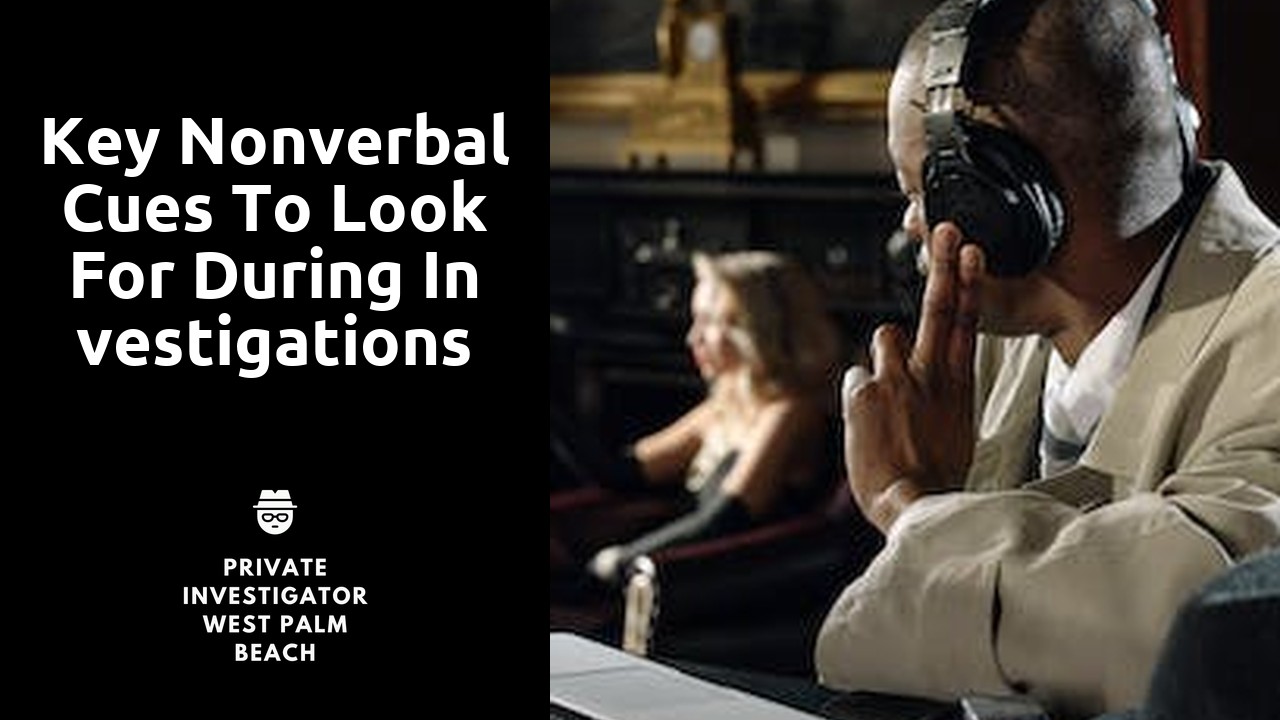
Key Nonverbal Cues to Look for During Investigations
Understanding the Silent Language: Unveiling Clues during Investigations
Nonverbal cues can often hold the key to unraveling mysteries in investigations. As investigators, it is crucial to master the art of understanding the silent language that lies beneath the surface of verbal communication. These unspoken messages can provide valuable insights and lead us closer to the truth.
One of the most powerful nonverbal cues is body language. Our bodies have a language of their own, expressing emotions, intentions, and even deception. By observing a person's posture, gestures, and facial expressions, we can gain a deeper understanding of their true feelings and motivations. A sudden shift in body position, a raised eyebrow, or a subtle frown can speak volumes, revealing concealed information that words alone might fail to convey. Therefore, honing our skills in interpreting body language is an essential tool in the investigator's arsenal.
The Power of Unspoken Messages: Decoding Nonverbal Cues in Investigations
Nonverbal cues can often provide valuable insights during investigations. While words may be spoken, the power of unspoken messages should not be underestimated. Nonverbal cues can include body language, facial expressions, gestures, and even the tone of voice. When properly decoded, these cues can unveil hidden information, emotions, and intentions that may not be explicitly expressed through words.
Observation plays a crucial role in decoding nonverbal cues during investigations. It is essential to be attentive to the subtle nuances in a person's nonverbal communication, as they can provide clues that may be crucial in uncovering the truth. For example, crossed arms may indicate defensiveness or resistance, while fidgeting could suggest nervousness or discomfort. By mastering the art of observation and understanding the language of the body, investigators can gain valuable insights and make informed decisions based on the unspoken messages conveyed.
Reading Between the Lines: Uncovering Hidden Clues in Investigations
In the world of investigations, the ability to uncover hidden clues can make all the difference in solving a case. While verbal communication often takes center stage, it is the nonverbal cues that can often reveal the most valuable information. Reading between the lines is not just about listening to what is being said, but also observing the subtle movements, gestures, and expressions that betray a person's true thoughts and emotions.
One of the key skills in uncovering hidden clues is mastering the art of observation. It is important to pay attention to the small details, as they can often be the key to unraveling a mystery. From the way a person fidgets nervously to the microexpressions that flash across their face, each nonverbal cue provides a glimpse into their inner world. By honing our observation skills, we can become adept at recognizing patterns and deciphering the silent language that lies beneath the surface.
Mastering the Art of Observation: Identifying Key Nonverbal Cues in Investigations
Observation is a fundamental skill that every investigator must master. In the world of investigations, the ability to keenly observe and interpret key nonverbal cues can make all the difference. Nonverbal communication, also known as the silent language, conveys a wealth of information that words alone cannot express. By honing their observation skills, investigators can tap into this rich source of hidden clues.
Identifying key nonverbal cues requires a keen eye and an understanding of human behavior. Facial expressions, body language, gestures, and even the tone of voice can all reveal valuable insights about a person's thoughts and intentions. Investigators must learn to read between the lines and decipher the unspoken messages that are conveyed through these nonverbal cues. It is through this mastery of observation that investigators can uncover hidden truths and piece together the puzzle of a case.
The Language of Body: Interpreting Nonverbal Signals in Investigations
Nonverbal communication plays a crucial role in investigations, as it often reveals more than what is spoken. The language of the body can provide valuable insights and uncover hidden clues that can lead to breakthroughs in solving cases. By paying close attention to nonverbal signals, investigators can master the art of interpreting these cues, allowing them to gain a deeper understanding of the situation at hand.
One important aspect of interpreting nonverbal signals is observing facial expressions. The face is a powerful tool for conveying emotions, and even the slightest twitch or change in expression can speak volumes. A furrowed brow may indicate confusion or concern, while a tight-lipped smile could be a sign of deception. By closely analyzing facial expressions, investigators can gain valuable information about a person's true thoughts and feelings, helping them to unravel the truth behind the case.
The Truth Behind the Gestures: Analyzing Nonverbal Communication in Investigations
Many times, the most important information in an investigation can be found in the gestures and nonverbal cues of those involved. When people speak, their words may not always reflect their true intentions or feelings. However, their body language often tells a different story. As investigators, it is crucial that we pay close attention to these subtle gestures in order to uncover the truth behind the words.
One common example of nonverbal communication that can reveal valuable clues is hand gestures. Hand movements can provide insight into a person's level of confidence, sincerity, or even deception. For instance, if a suspect repeatedly touches their face or covers their mouth while answering questions, it could be a sign that they are not being entirely truthful. On the other hand, open and relaxed hand gestures may indicate honesty and cooperation. By carefully analyzing these small but significant gestures, investigators can gain a deeper understanding of a person's true intentions and emotions.
Related Links
Understanding Body Language in Interrogation SituationsImportance of Nonverbal Communication Analysis in Private Investigation
Integrating Psychological Understanding in Investigations
Using Psychological Profiling to Solve Cases
Psychological Tactics in Interrogation
The Importance of Active Listening in Investigations